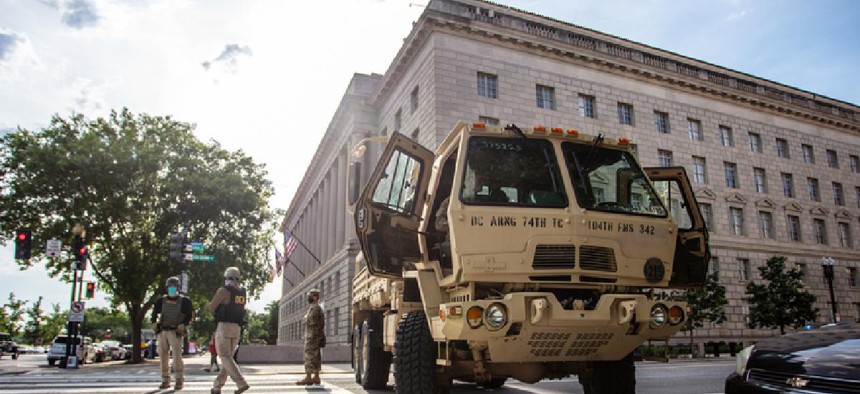Military leaders try to walk a fine line amid protests against police violence

Defense Secretary Mark Esper and other senior officials signaled opposition to the use of active duty troops to police nationwide protests, but are running up against a commander-in-chief who appears to welcome conflict.

A military-style vehicle guards an intersection near the White House. June 2, 2020. Image credit: Johnny Silvercloud/Shutterstock)
Defense Secretary Mark Esper said Wednesday morning in a hastily called press conference that he opposed any deployment of active-duty military members to quell nationwide protests following the police killing of George Floyd in Minneapolis -- a move that appears to break from President Donald Trump’s position.
“The option to use active duty forces in a law enforcement role should only be used as a matter of last resort, and only in the most urgent and dire of situations,” Esper told reporters during a news conference June 3. “We are not in one of those situations now.” He said he did “not support invoking the Insurrection Act,” which allows the president to operationalize the military in times of civil unrest and certain circumstances.
Later the same day, as reported by the Associated Press, Esper overturned an order to return active duty troops who were mobilized to Washington, D.C. area installations to their home bases.
Chief of Staff Gen. Mark Milley told the heads of the Joint Forces in a June 2 memo to "please remind all our troops and leaders that we will uphold the values of our nation, and operate consistent with national laws and our own high standards of conduct at all times." In handwritten note included in the memo, Milley wrote, "we all committed our lives to the idea that is America – we will stay true to that oath and the American people."
Later the same day, former Defense Secretary Jim Mattis published a statement in the Atlantic denouncing Trump and his handling of the public protests.
"Donald Trump is the first president in my lifetime who does not try to unite the American people -- does not even pretend to try," Mattis wrote. "Instead he tries to divide us. We are witnessing the consequences of three years of this deliberate effort."
Trump hit back at Mattis on Twitter, but so far appears to be tolerating, at least publicly, the signals from top Pentagon officials that they were not interested in the invocation of the Insurrection Act.
The president has routinely pushed out senior defense officials he has come to dislike or distrust, including Mattis, and, most recently, Glenn Fine, DOD’s principal deputy inspector general. Fine resigned effective June 1 after Trump removed him from an independent group in charge of overseeing pandemic spending in May, CNN reported.
Esper and Milley's public statements came after coming under fire for participating in a photo opportunity in front of the historic St. John’s church across from the White House June 1. The secretary initially denied knowing about the president’s intention to speak in front of the church, telling NBC that he was going with Trump to inspect a vandalized bathroom. On June 3, Esper said he knew the president was going to make remarks.
In his remarks on Wednesday, Esper said he wanted to give DOD leaders "the space" to express themselves on the issues of racism and police brutality.
Even before this announcement, Air Force Chief Master Sgt. Kaleth Wright, the senior posted a passionate letter on his social media accounts, drawing the similarities to him and Floyd.
"Who am I? I am a Black man who happens to be the Chief Master Sergeant of the Air Force. I am George Floyd," Wright wrote.
Wright went on to say that one of his greatest fears was waking up to a news report that one of his black airmen was killed by a white police officer.
“I hope you realize that racism/discrimination/exclusion does not care much about position, titles or stature," he wrote. "[S]o yes, it could happen to you, or one of your friends, or your Airmen, or your NCOIC, your Flight Chief, your Squadron Commander or even your Wing Commander.”
NEXT STORY: OPM looks to its own reopening






